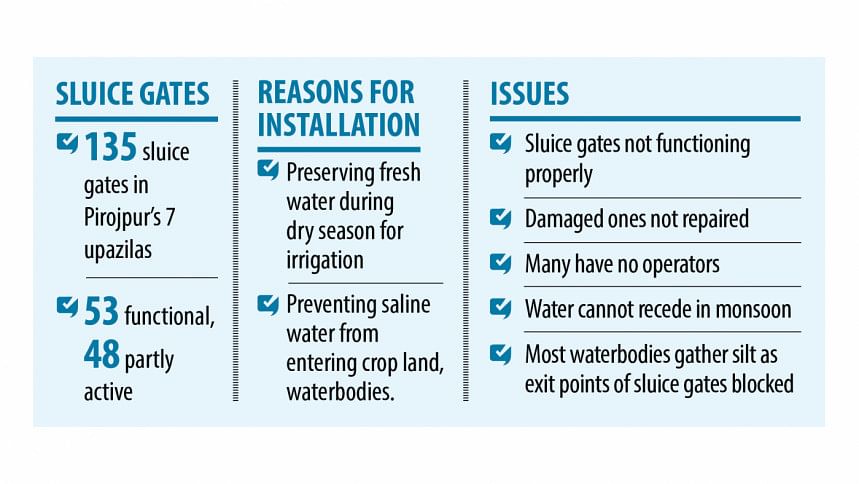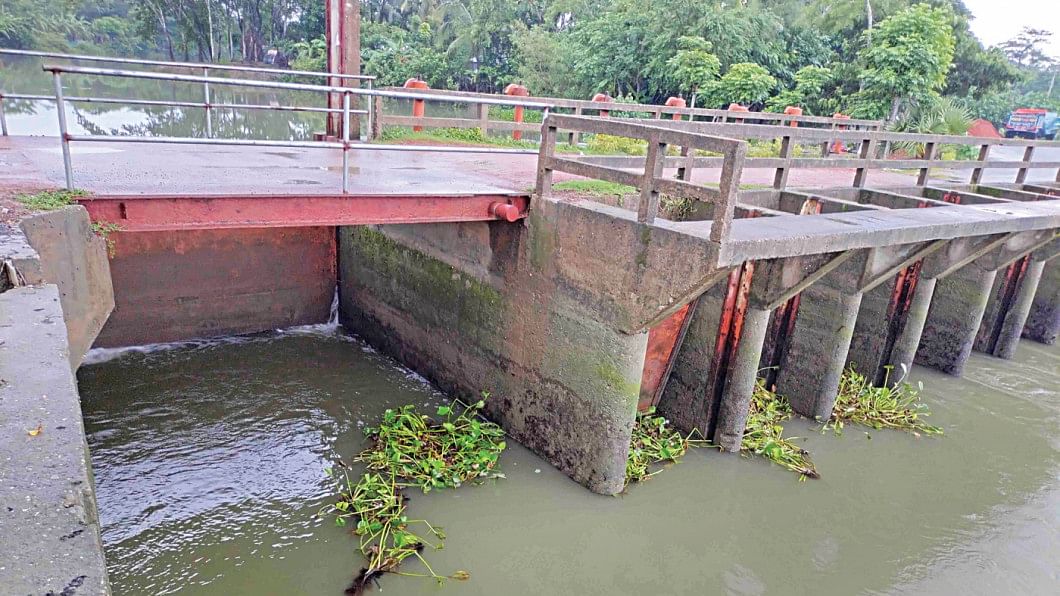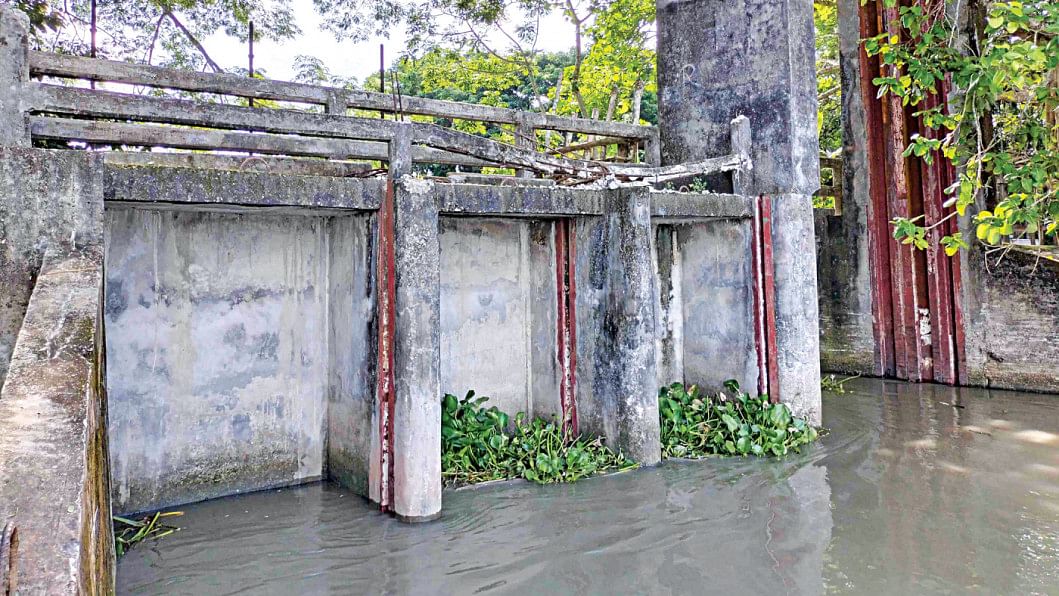Unplanned sluice gates a curse for coastal districts
Once a fisherman, Sagir Hossain Somed, 55, of Dakshin Gilabad village of Pirojpur's Mathbaria upazila, switched to farming after fish population depleted alarmingly within a few years of the construction of a sluice gate in neighbouring Dadhibhanga village.
However, Somed is facing serious trouble in farming as well, for the same reason.
"Before the construction of sluice gate, we suffered due to flooding mainly during monsoon. Now, we are facing a double problem as we are not getting water when we need it for farming while, if it rains heavily, water is trapped inside sluice gate areas hampering seasonal paddy cultivation," Somad said.
He also said all the waterbodies including canals have been silted up, depleting the local fish population. "Fishing in these waterbodies is a distant memory now," he lamented.
The same type of sluice gates, embankments, culverts, and flood protection dams are not applicable for the entire country due to its diverse geographical conditions. However, sluice gates have been constructed in the same format across the country without considering the location's geography and ecosystem.
Like Somed, thousands of people in Pirojpur are compelled to change their livelihoods due to unplanned installation and lack of maintenance of sluice gates on different canals, according to locals and experts.

Md Younus Mridha, 60, another villager, said the sluice gates have disrupted their entire lifestyle.
"Now we can grow paddy only once a year instead of twice like before, since we no longer get water in the canals and ponds during the dry season. We are also facing difficulties in carrying goods through waterways as canals have silted up," Mridha said.
Canals are an important means of communication for the local residents.
Mahendranath Baral of Dadhibhanga said the sluice gate in their village has been in a sorry state for many years.
"No step has yet been taken to repair the damaged sluice gate. Besides, only one operator was there to maintain it," Baral said.
According to the Water Development Board (WDB), there are 135 sluice gates in Pirojpur's seven upazilas. Of those, 53 are active and 48 are partly active for water extraction.
The WDB installed those gates in the coastal districts mainly for two reasons -- preserving fresh water during dry season for irrigation and preventing saline water from entering crop land and waterbodies.

However, the locals said the sluice gates are hardly serving the purpose.
Around 12 years ago, a sluice gate was constructed in Kalakhali village of Pirojpur Sadar upazila defying locals' protests.
"The government constructed it without paying heed to our demand or considering its necessity. Now we do not get enough water for cultivation even during monsoon," said Masud Dakua of the village.
Like that one, several sluice gates have been constructed on the canals leading to Baleshwar river in Pirojpur Sadar and Indurkani despite protests, locals said.
Operation of those sluice gates remain suspended in the absence of maintenance works.
"Before the construction of the sluice gates, the canals were abundant with local fish species. Now, fishes are no longer found. Instead of bringing benefits, sluice gates brought misery to us," said Al Mamun, a local.
A recent research on two sluice gates at Charghat upazila of Rajshahi district and Baraigram upazila of Natore district, published in the Research Gate in 2013, shed some light on their detrimental effect on fisheries, agriculture and normal life.
Due to the construction of the sluice gates, many species of fish have vanished from rivers. During monsoon, people face serious waterlogging while during dry season they face acute water crisis as the river mouth has been silted up, said the researchers from Rajshahi University and Sher-e-Bangla Agricultural University in Dhaka.
Mir Mohammad Ali, chairman of the department of aquaculture at Sher-e-Bangla Agricultural University, who was a member of the research team, said the situation has remained the same as it was 16 years ago.
"Though we found out the troubles of sluice gates, the authorities concerned did not take any suggestion," Mohammad Ali said, adding that the sluice gate areas must be excavated to remove the silt gathered there to revive flow of water and bring back fishes.
Mohammad Nazrul Islam Sikder, deputy director of the Department of Agricultural Extension in Pirojpur, said WDB and other authorities never consulted with the agriculture department or fisheries office before constructing a sluice gate.
"Construction of unplanned and often unnecessary sluice gates is hampering our agriculture badly by turning many areas barren," said Sikder.
Abdul Bari, a fisheries officer, echoed the same.

"Unplanned and unattended sluice gates are posing a serious threat to biodiversity and local aquatic species," Bari said.
Ecology and biodiversity researcher Pavel Partha said the same type of sluice gates, embankments, culverts, and flood protection dams are not applicable for the entire country due to its diverse geographical conditions.
"However, sluice gates have been constructed in the same format across the country without considering the location's geography and ecosystem," Partha said.
He also said water of the 19 coastal districts carrying huge amounts of sand and silt is trapped inside the sluice gates, forcing the canals to die.
"But the engineers involved with the design either never consider the issue or do not understand it," he said.
He urged for more research and coordination among the authorities before the construction of a sluice gate.
Contacted, Nusaeir Hossain, executive engineer of WDB in Pirojpur, said construction of sluice gates began around 1962 and those in Pirojpur were constructed around 1985. He claimed that none of those has been constructed unnecessarily or without a feasibility study.
"We have no allocation for the maintenance of the sluice gates. Besides, due to a lack of manpower we cannot repair those, although it is necessary," he said.
"Every year, we send in some demand as the maintenance cost. But our demand is never accepted," he also said.
However, he could not specify how much funds they needed for the maintenance works. He also could not provide any information on how much public money was spent for the construction of each sluice gate in Pirojpur.
Locals are also responsible for the damage of the sluice gates as they make structure inside canals and steal different parts of the sluice gates, he alleged.
"If the sluice gates are repaired and manpower is appointed to look after them, water flow in the canals will become normal," he said.

 For all latest news, follow The Daily Star's Google News channel.
For all latest news, follow The Daily Star's Google News channel. 




Comments